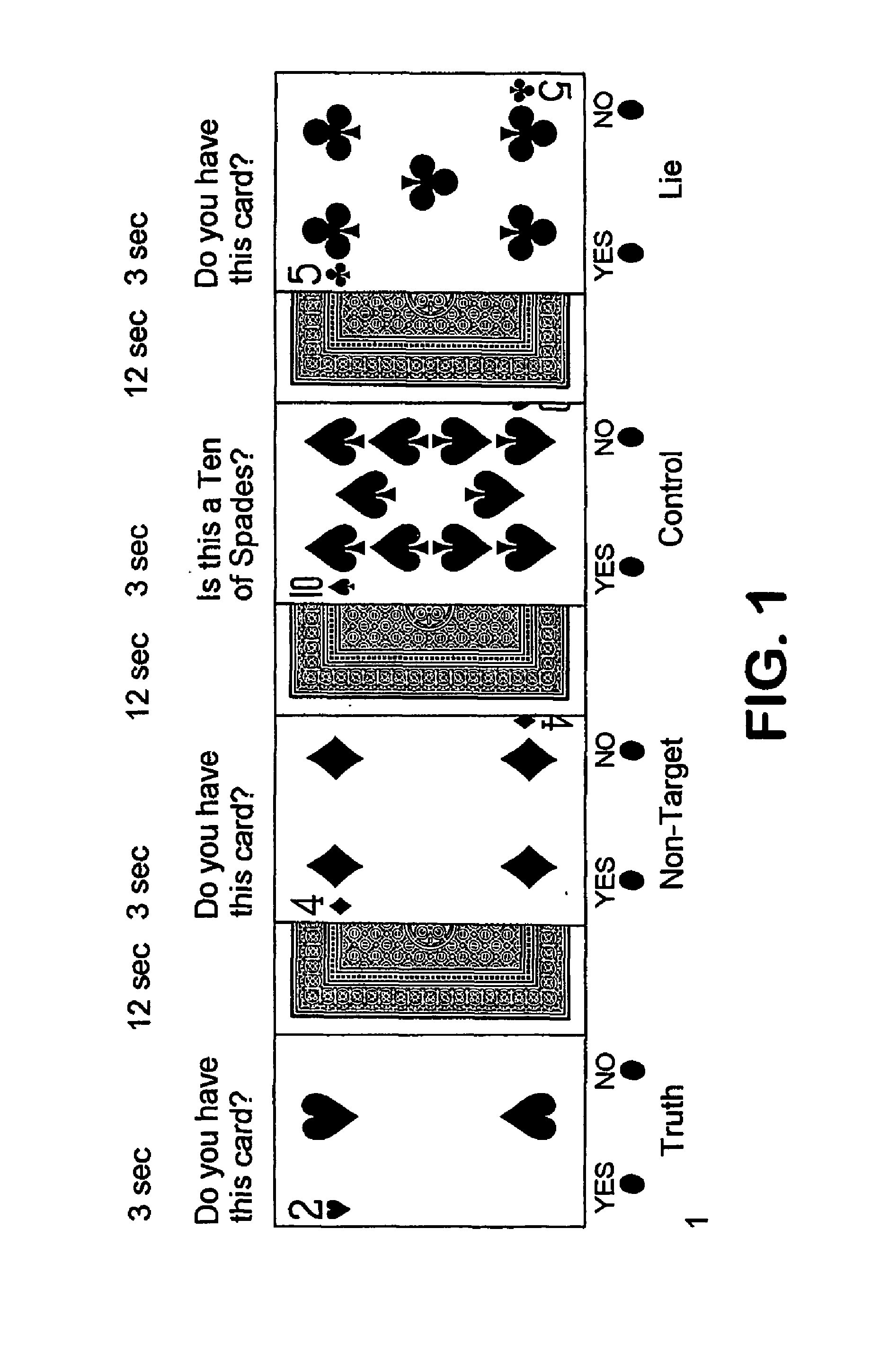Functional brain imaging for detecting and assessing deception and concealed recognition, and cognitive/emotional response to information
a functional brain imaging and concealed recognition technology, applied in the direction of instruments, magnetic variable regulation, analysis using nuclear magnetic resonance, etc., can solve the problems of limiting the means available to law enforcement agencies, reducing the value and reliability of any information obtained, and questioned the validity and accuracy of polygraph results. , to achieve the effect of reducing the value and reliability of any information
- Summary
- Abstract
- Description
- Claims
- Application Information
AI Technical Summary
Benefits of technology
Problems solved by technology
Method used
Image
Examples
example 1
A GKT Test Study
[0053]Twenty-three (23) healthy right-handed participants (11 men and 12 women) ages 22 to 50 years (average 32), education 12-20 years (average 16), were recruited from the University of Pennsylvania community. Participants were screened with Symptom Checklist-90—Revised (SCL-90-R) and a DSM-IV-based interview (American Psychiatric Association Diagnostic and Statistical Manual, 4.sup.th Edition (DSM-IV))-based interview to assure psychological normalcy before the scan. They were also questioned about symptoms of anxiety, if any, experienced during and / or after the scan {SCL-90-R items 2, 4, 12, 17, 23, 31, 39, 55, 57, 72, 78} (see survey published by Derogatis, et al., Br. J. Psychiatry 128: 280-289 (1976)).
[0054]A “high-motivation” version of the GKT described by Furedy et al., 1991, was adapted as follows: (1) instead of handmade cards with written numbers, numbered playing cards (FIG. 1) were used, (2) two non-salient card types were added to ensure alertness and...
example 2
Recognition of Familiar Faces
[0069]A conspiracy suspect trying to intentionally deceive an investigator about being acquainted with another individual (e.g., a co-conspirator) exhibits two parameters of brain function detectable by fMRI. The first is intentional denial of recognizing the co-conspirator (or his / her image). The second is response to a familiar face or object, which is different from the response to a novel face or object.
[0070]Studies of brain activity patterns during facial recognition have shown significant differences in the brain response to familiar vs. novel faces as well as the effect of the degree of prior familiarity with the displayed face (Haxby, 2002; Glahn et al., 1997; Henson et al., 2001; Schlack et al., 2001, Gobbini et al., 2001). Thus, when the principles of Example 1 are applied to the question of whether an individual recognizes a face or not, the present data indicates that when faces are used as stimuli in a GKT type paradigm a response is as str...
example 3
Brain Response to Media Information
[0072]The principles set forth in the fMRI deception paradigm of Example 1 may also be applied to individuals viewing media information, such as movies, video film clips, or advertising. Although in this case, rather than examining for deception, the data is used to interpret the effect of the information on the individual. This uses the known patterns of brain response, e.g., aversive, pleasurable, exciting or memory-evoking stimuli to adjust media content to achieve a desirable impact. This study explores the use of magnetic resonance signal as a marker of cognitive (e.g., attention) and emotional (e.g., arousal) responses to commercial audiovisual media Subjects are selected and analyzed as in Example 1 with certain modifications in the presentation and evaluation of the signals and resulting data.
[0073]Subjects view the baseline media segment (control material) followed by the target media segment of same duration (While random...
PUM
| Property | Measurement | Unit |
|---|---|---|
| time | aaaaa | aaaaa |
| time | aaaaa | aaaaa |
| magnetic field | aaaaa | aaaaa |
Abstract
Description
Claims
Application Information
 Login to View More
Login to View More - R&D
- Intellectual Property
- Life Sciences
- Materials
- Tech Scout
- Unparalleled Data Quality
- Higher Quality Content
- 60% Fewer Hallucinations
Browse by: Latest US Patents, China's latest patents, Technical Efficacy Thesaurus, Application Domain, Technology Topic, Popular Technical Reports.
© 2025 PatSnap. All rights reserved.Legal|Privacy policy|Modern Slavery Act Transparency Statement|Sitemap|About US| Contact US: help@patsnap.com



